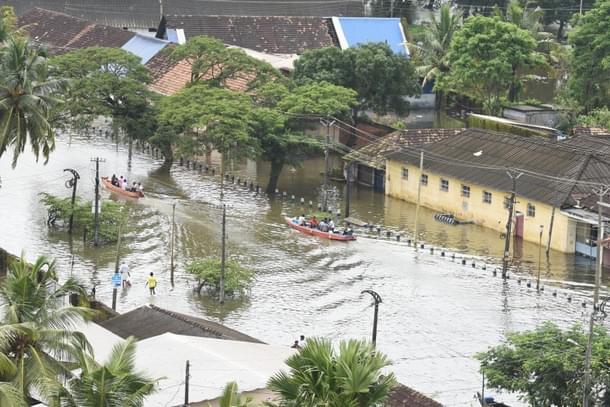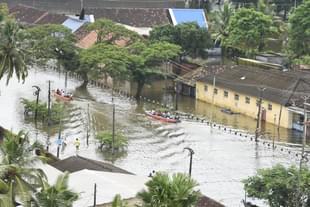Ideas
Natural Disasters Need Relief Efforts, Not Labels Of ‘Divine Retribution’
Aravindan Neelakandan
Aug 21, 2018, 06:31 PM | Updated 06:31 PM IST
Save & read from anywhere!
Bookmark stories for easy access on any device or the Swarajya app.


Sri Jayendra Saraswati was arrested and imprisoned. The Tamil Nadu media, in a journalistic equivalent of mob lynching, ran a virulent campaign against him. This happened in November 2004. Soon after Christmas that year, a tsunami struck. Southern India was shattered, and Tamil Nadu was the worst hit where thousands of people were killed.
Some over-zealous devotees saw in the tsunami a divine retribution for the arrest of the acharya. But, Jayendra Saraswati himself did not endorse this. He sent a message from the prison that he was deeply saddened and that he would pray for the atmans of the departed. He added that he shared the agony of the families who had lost their near and dear ones. This gesture of the acharya reflects the values of Sanathan Dharma, which have to be learned and imbibed in by those of us who rush to see in the floods of Kerala a divine retribution against the moves to allow women of menstruating age to visit the Sabarimala temple.
Primitive minds saw divine punishments in natural disasters. There are religions which have built elaborate theology around fears of divine punishment for human transgressions. In India too, there have been fears of such gods who wreak punishments. However, Hinduism overcame such fears with the Sankhya Darshana on the one hand and the Vedantic Brahman on the other.
In the Biblical tradition, the deluge happens because the creator-deity is angry. So he destroys the entire population as a punishment. Hindu thinker Ram Swarup called such a creator-deity an ego-god. This conception of god as the punishing deity arises from the ego planes of the mind. In Hindu cosmology, the deluge or the final dissolution happens not because of divine anger but as part of natural cycles.
Vedanta Desika says that it is the daya or divine feminine compassion of the godhead that creates this cosmic dissolution. Even when the living beings, including humans, commit errors, there is no anger but only compassion from the deity. Pralaya or cosmic dissolution brings to end all the errors committed by all life forms. But there is no anger in the deity. There is, perhaps, a karmic entropy but no divine collective punishment for individual sins.
The Puranas have their own language and narrative to take this vision to the people. Puranic language is aesthetic, emotional and has a deeply embedded darshana. According to the Bhagavatam, Indra, the sky-borne deity, sent torrential rains to punish people who refused to give him offerings. Sri Krishna, who prevailed upon his people to worship the earth-bound Govardhan mountain and not Indra, lifted that very mountain and shielded them from the downpour.
Here is an example of ego-god and fear-centric theology conquered by a deeper spirituality. Krishna, with the Govardhan hill resting on his little finger, stands as a guardian against our own juvenile tendencies to attribute anger arising from petty human mistakes to the divine, and see in every flood, every earthquake and every plague, a divine retribution.
In Tamil Nadu, a local Buddhist legend speaks of Puhar, the port city of the Cholas that was destroyed by the sea goddess as the king forgot to observe the festival of Indra. When the seer-poet Manickavasagar was imprisoned by a Pandya king, Lord Shiva raised the water levels threateningly in the Vaigai river. However, in what can be described as more a divine play than divine anger, Shiva himself gets caned by the king.
An enraged Kannagi ofSilapadikaram, while commanding fire to destroy Madurai, orders it to spare the elderly, women, children and the pious and punish only the wicked.
The flood narratives exist throughout the world. In the Puranic narrative, the divine anger is in no way related to deluge. It is only a natural cycle. Even so, Manu was able to survive the floods because he would show compassion to the fish and give it shelter from the ‘big-fish-eat-small-fish’ order that exists in nature. So here, human nature that goes against the ‘survival of the fittest’ law is seen not as an affront against nature but as an elevating, and ultimately, life-saving principle.
The quest for justice, and debates related to that quest, however vexing they are for the traditional minds, and how much ever perversely misused by the Hindu-phobic and pseudo-secular left, can still have only a positive effect on the overall welfare of the society and will make the moral compass of the society better.
Coming back to Manu, when he saved the fish from the prevailing law of ‘the big fish eating small fish’, he did go against the law of blind nature but through that transgression, he saved his own society and the life forms from the destruction. Only a twisted mind would say that the floods occurred because Manu ‘transgressed’ the laws of nature. Dharma is an ever watchful principle that acts against stagnant beliefs which lead to blind rigidity and injustice.
So, let us debate and have dialogues over every tradition and let us conserve the traditions or adapt them to modern requirements as we see fit. Definitely, Aiyappa Swami who embodies the Upanishadic Tat Tvam Asi, is not an ego-god like Indra or the deity of the crude evangelical kind to punish innocent women and children collectively for the perceived transgressions of a few.
The Original Sin is collective.
The myth of blood curse of Jesus that was used to persecute Jews and fuel anti-Semitism is collective.
Karma is largely individualistic.
In 2016, the all-India representatives council of the Rashtriya Swayamsevak Sangh (RSS), the Akhil Bharatiya Pratinidhi Sabha or ABPS, passed a resolution that sought the elimination of practices that restrict the entry of women in certain Hindu temples. It also supported the idea of women becoming priests.
This is what happens in a civilised social organism. When the Sangh passed these resolutions, it showed the publicity seeking Hindu-phobic feminists that Sangh, and hence Hindu society itself, is ready to engage in debate and dialogue for social transformation. A transformation that would go beyond binary constructs like ‘Brahminical Hindu patriarchy’ versus ‘enlightened progressive feminism’, which though high sounding, are mediocre and meaningless in the Indian context.
Swami Aiyappa, the presiding deity of the Sabari hills, would be happier with the approach like the one taken by the Sangh than ascribing the floods to his anger.
Far from being the cause of such tragedies, the divine reveals herself in the efforts, human or otherwise, to relieve the pain caused by natural and man-made disasters, says Sri Lalita Sahasranama. She is the moon light of healing that douses the fire of suffering created by disasters (thaapathrayaagni santhaptha sama ahlaadana chandrikaa, name 357). Every hand that helps now is her hand.
Aravindan is a contributing editor at Swarajya.





